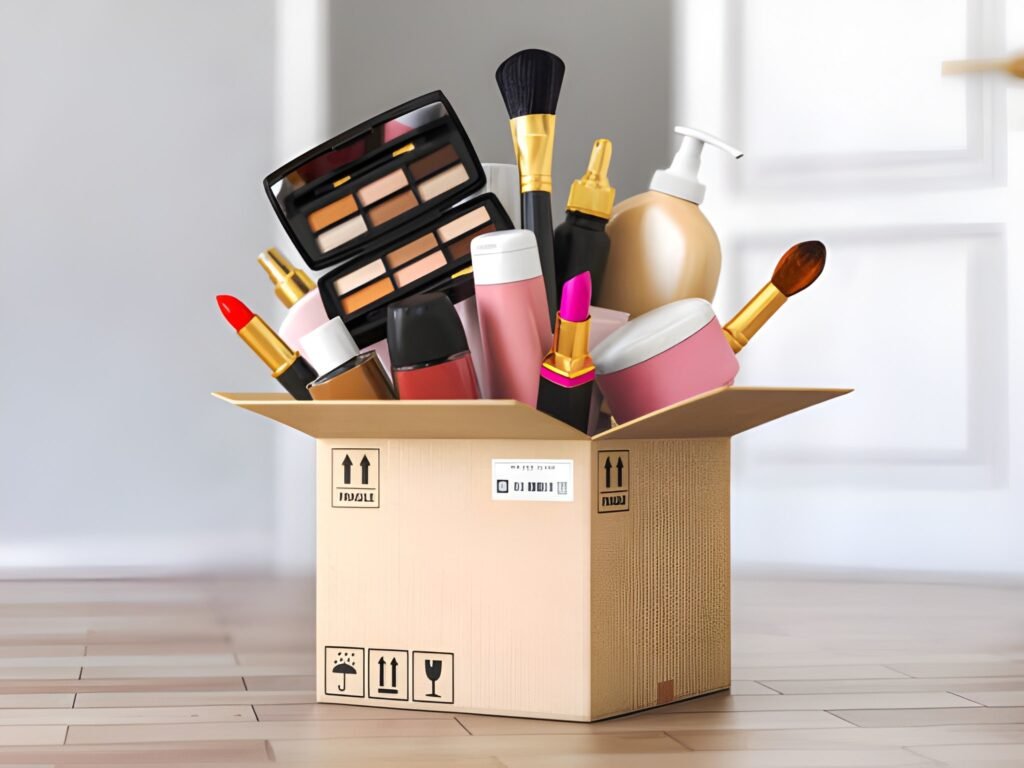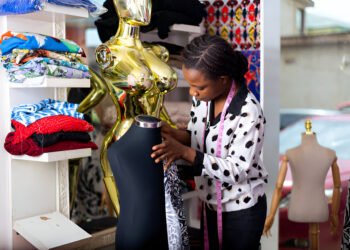
If there’s ever been a best time for beauty entrepreneurs, it’s now. The beauty industry has exploded into one of the fastest-growing and most creative business landscapes in the world.
What used to be a domain dominated by legacy cosmetic giants has become a playground for independent founders, digital creators, and small brands redefining what beauty means and how it’s sold.
In 2030, the opportunity is enormous. Global beauty and personal care revenue is projected to exceed $937.13 billion, driven by rising consumer demand for self-care, inclusivity, and technology-led experiences. The U.S. alone accounts for nearly a quarter of that market, where emerging brands continue to attract audiences hungry for authenticity, innovation, and ethical values.
What makes this moment different isn’t just market size, it’s accessibility. Anyone with a smartphone, some creativity, and an understanding of what people want can build a thriving beauty business.
Whether you’re formulating skincare from your kitchen, creating digital beauty tutorials, or running an AI-powered salon, the barrier to entry has never been lower, and the upside has never been higher.
But this is also a competitive landscape. The difference between a hobby and a million-dollar business often lies in strategy, branding, and execution. That’s why this guide provides a comprehensive overview of the best beauty business ideas, practical steps, and the mindset necessary to thrive in one of the world’s most dynamic industries.
Why Now Is The Best Time To Start A Beauty Business
Every decade, a few industries redefine what it means to be an entrepreneur. For the 2020s, beauty sits firmly at the top of that list, merging wellness, fashion, and technology into a sector that evolves faster than any other consumer market.
Here’s what’s driving the next wave of million-dollar beauty brands.
1. The Industry Has Gone Borderless
In 2026, beauty is no longer defined by geography. Thanks to e-commerce and social platforms, a solo founder in Atlanta can sell skincare to customers in Paris, Lagos, or Tokyo without ever leaving home.
The rise of global direct-to-consumer (DTC) platforms like Shopify, TikTok Shop, and Amazon Beauty has given international access, giving independent brands the same distribution reach once reserved for multinational corporations.
That borderless reach has fueled micro-brand culture, where niche products thrive. From vegan lip oils to Korean-inspired scalp treatments, consumers are choosing brands that reflect their values, not just their vanity.
2. The Rise of “Conscious Capitalism” in Beauty
Consumers have become smarter and far more selective. They care about ingredient transparency, sustainability, and ethical sourcing as much as they do packaging and results. This has pushed the industry toward “clean beauty” and “slow beauty” categories that are not just trends but evolving standards.
Founders who take advantage of this and create businesses around this trend are the ones who are winning. Eco-friendly packaging, cruelty-free formulas, and refillable systems are no longer marketing gimmicks. They’re expectations. The brands that build trust through transparency, showing where ingredients come from and how they impact communities, are the ones building long-term loyalty.
3. Beauty Is Now Deeply Technological
It’s easy to think beauty is all artistry, but the truth is, technology has become its heartbeat.
Artificial intelligence is now used for product recommendations, AI-generated shade matching, and skin diagnostics. Augmented reality (AR) enables virtual try-ons, while data analytics refines product development and inventory forecasting.
In practical terms, this means entrepreneurs don’t need massive R&D budgets anymore. What they need is access to smart tools. Platforms like ModiFace, Perfect Corp, and YouCam Makeup offer plug-and-play solutions for small beauty startups to deliver digital experiences once only Sephora could afford.
For example, virtual consultations and AI-powered quizzes can greatly personalize a customer’s beauty routine, a small brand’s secret weapon for conversion.
4. Social Media Remains the Ultimate Beauty Launchpad
Social media made the beauty industry open and accessible to everyone, not just big brands or professionals.
Before platforms like YouTube, Instagram, and TikTok, beauty was largely controlled by corporations, magazines, and celebrity endorsements. They decided which trends mattered, which products got exposure, and who represented “beauty.”
When social media came along, it made the beauty industry literally accessible to everyday creators and consumers. Anyone could share tutorials, review products, start a brand, or influence trends, often from their bedroom or smartphone.
And the combination of visual storytelling and emotional appeal makes TikTok, Instagram, and YouTube ideal playgrounds for beauty founders. What’s changed is the how: micro-influencers and user-generated content now drive most sales.
It’s not about celebrity endorsements anymore, but rather about authenticity, and that’s where small businesses excel. A single viral GRWM (“get ready with me”) clip can generate tens of thousands in revenue overnight. But you’ll have to be consistent with pairing valuable content with genuine brand storytelling.
If you can create content that teaches, entertains, and connects, you’re already halfway to building a profitable beauty brand.
5. Diversity and Representation Are Reshaping Demand
The modern beauty consumer wants to see themselves reflected in the products they use, meaning you have to include the average customer in shade ranges, textures, marketing, and brand voice. Inclusivity is no longer an optional feature; it’s a growth strategy.
Global brands that once ignored underrepresented markets are now scrambling to catch up, while independent founders are leading the charge with products for every skin tone, hair type, and identity.
From Black-owned skincare brands gaining shelf space in major retailers to gender-neutral beauty lines normalizing inclusivity, this evolution is both cultural and commercial. Entrepreneurs who build with empathy and representation in mind are finding not only an eager audience but also investor support.
6. Wellness and Beauty Have Officially Merged
Beauty is no longer skin-deep. The fastest-growing segments in 2026 are holistic wellness, nutritional beauty, and biohacking-inspired skincare. Consumers want beauty that works from the inside out, making collagen supplements, adaptogenic skincare, stress-reducing aromatherapy, and microbiome-friendly formulations all part of this evolution.
This crossover between beauty and health opens new business frontiers: from wellness spas to ingestible beauty supplements to mindfulness-based skincare rituals. The lines between “self-care” and “commerce” have blurred, creating immense opportunity for founders who understand both sides.
Low-Cost Beauty Business Ideas (Under $5,000 to Start)
1. Mobile Beauty Services
Startup costs: $2,000-$5,000
Earning potential: $40,000-$100,000+
If you’ve got beauty skills but don’t want to pay for a salon space, take your services on the road. You can offer makeup, hairstyling, manicures, or even facials at people’s homes or offices.
Clients love the convenience of getting ready in their own space, and they’ll pay more for that comfort. With good tools, a reliable vehicle, and a solid online presence (Instagram helps a lot here), you can build a busy client list fast. Once you’re booked regularly, consider adding more stylists under your brand to grow your income.
2. Beauty Affiliate Marketing
Startup costs: $0-$500
Earning potential: $10,000-$150,000+
If you love sharing products online, affiliate marketing is a simple way to earn from your recommendations. You promote beauty products on platforms like YouTube, Instagram, or TikTok and earn a commission when someone buys through your link. You can also promote products through a blog site if you’re not a social media person.
Start by joining affiliate programs from brands like Sephora, Ulta, or Amazon. To make more money, you can focus on premium products like hair tools, skincare devices, or pro makeup kits, where the commissions are impressive. With consistency, this side hustle can turn into a steady stream of passive income.
3. Freelance Makeup Artist
Startup costs: $2,500-$6,000
Earning potential: $30,000-$120,000+
Being a makeup artist gives you the freedom to work on your own terms. You can start by building a small kit, creating a simple portfolio, and offering your services for events like weddings, photoshoots, or parties.
Start with friends, collect testimonials, and post before-and-after photos online. Over time, your reputation will bring referrals. You can later expand into teaching classes or offering online consultations, giving you a higher and more consistent income all year-round.
4. Lash Extension Services (Home-Based)
Startup costs: $2,000-$6,000
Earning potential: $50,000-$120,000+
Lash extensions are one of the most profitable services you can offer from a home studio. Clients come back every two to three weeks for fills, so it’s a great way to build recurring income.
You have to be precise and hygienic with your services. Take a professional lash course, set up a comfortable workspace, and invest in quality supplies. Once your clients trust your work, they’ll keep coming back and probably bring their friends too.
5. Beauty Product Reselling
Startup costs: $500-$2,000
Earning potential: $20,000-$80,000+
You don’t have to create your own products to sell in the beauty industry. You can buy authentic items at wholesale or discount prices and resell them online through platforms like eBay, Mercari, or Facebook Marketplace.
Focus on high-demand or hard-to-find products, like limited-edition skincare or imported Korean beauty brands. Start small, test what sells, and reinvest your profits. Over time, you can build your own online beauty store without ever developing a single formula.
6. Beauty Consulting Services
Startup costs: $500-$2,000
Earning potential: $40,000-$150,000+
If you know your way around the beauty industry, maybe from working in salons, retail, or product development, you can sell your expertise as a consultant. Small beauty brands and new entrepreneurs often need help with product launches, branding, or marketing strategies.
Your knowledge is the product here. You can work remotely, meet clients virtually, and charge by the hour or per project. A good website and professional branding go a long way. Over time, satisfied clients become your best promoters.
7. Dropshipping Beauty Products
Startup costs: $500-$2,000
Earning potential: $25,000-$150,000+
Dropshipping lets you sell beauty products online without holding inventory. You set up an online store, promote products, and your supplier handles storage and shipping.
It’s a competitive model, but it works well when you focus on a niche, for example, clean skincare for sensitive skin or men’s grooming products. Your job is to market your brand, create a strong story, and deliver a shopping experience that feels trustworthy. Once you find products that sell, you can scale quickly with minimal overhead.
8. Online Beauty Tutorials
Startup costs: $800-$2,500
Earning potential: $20,000-$200,000+
If you’re good at explaining things and enjoy being on camera, teaching beauty techniques online can become a serious business. Start with short videos on YouTube, TikTok, or Instagram. Once you grow a following, you can earn from ad revenue, brand sponsorships, affiliate links, or even your own online courses.
Choose a niche audience like mature skin makeup, acne-prone skincare, or natural haircare. People love creators who help them solve real problems. And the best part? You can start with just your phone, good lighting, and time.
9. Nail Technician (Home-Based)
Startup costs: $1,500-$4,000
Earning potential: $35,000-$90,000+
If you’re skilled with nail design and enjoy creative detail work, opening a small home-based nail studio can be a smart way to break into the beauty industry. You’ll save on overhead by working from home while still offering the same professional services clients expect from a salon.
Once you build a steady base of loyal clients returning every few weeks, your earnings become consistent. You can also add retail nail care products or aftercare kits to boost profits and give clients a reason to keep coming back.
With social media marketing and strong local word of mouth, many home-based nail techs earn a full-time income without ever renting a salon chair..
10. Brow Services (Home-Based)
Startup costs: $1,000-$3,500
Earning potential: $30,000-$85,000+
Brows have become a beauty essential, and services like tinting, waxing, lamination, and shaping keep clients coming back every few weeks. It’s a small-space business you can run from home with minimal setup.
The secret is consistency. Once you master the art of shaping and matching brows to face shapes, your clients will trust no one else. You can also expand later by offering lash lifts or combining services into package deals.
Mid-Range Beauty Business Ideas ($5,000-$25,000 to Start)
11. Private Label Skincare Line
Startup costs: $7,500-$25,000
Earning potential: $50,000-$300,000+
You don’t need to invent a new formula to launch a skincare brand. With private-label manufacturing, you can work with labs that already make proven products and simply add your own branding, packaging, and story. It’s one of the easiest ways to enter the cosmetic industry without starting from scratch.
You’ll spend most of your budget on packaging design and marketing, which is what really sets your brand apart. Focus on what your line stands for, which includes clean ingredients, gentle formulations, or solutions for a specific skin type. That focus helps your products stand out in a crowded market.
12. Beauty Subscription Box
Startup costs: $10,000-$25,000
Earning potential: $40,000-$200,000+
Subscription boxes remain a favorite for beauty lovers who love trying new things. Whether it’s clean skincare, indie brands, or Korean beauty, customers enjoy the surprise factor and convenience of curated products arriving at their door.
To make your box stand out, curate with intention. Include high-quality samples, small indie brands, or themed collections that feel personal. As your subscriber base grows, you’ll enjoy recurring income and predictable sales every month, something few businesses can offer.
13. Microblading Studio
Startup costs: $9,000-$20,000
Earning potential: $60,000-$180,000+
Brows frame the face, and people are willing to pay well for ones that look natural. Microblading, which is a semi-permanent technique using fine strokes to mimic natural hairs, has become a go-to service for clients who want long-lasting, natural-looking brows.
The training and tools cost more upfront, but the payoff is strong. Clients pay premium rates, and many return for yearly touch-ups. If you have a steady hand, patience, and an eye for detail, this business can be both creative and lucrative.
14. Organic/Clean Beauty Products
Startup costs: $10,000-$30,000
Earning potential: $50,000-$350,000+
More consumers now read ingredient lists and care about what goes on their skin. Clean beauty focuses on safe, simple, and often plant-based formulations. You could create a skincare or makeup line that’s transparent about ingredients and sustainability.
This business is all about trust. Be clear about where your ingredients come from and what makes your products different. You don’t have to compete with big brands. Just be authentic. Customers who share your values will naturally gravitate toward your line.
15. Mobile Spray Tan Business
Startup costs: $3,000-$8,000
Earning potential: $30,000-$80,000+
Spray tanning has become one of the easiest beauty services to take on the road. Instead of renting a studio, you can bring the experience to your clients at home, at events, or even at pop-up locations.
All you need is a professional tanning kit, good lighting, and a small portable tent. The service is quick, often 15–20 minutes per client, and people are willing to pay extra for the convenience. Weddings, vacations, and photo shoots keep demand steady year-round. Once you build a loyal client base, you can even hire other technicians to expand your reach.
16. Hair Extension Business
Startup costs: $9,000-$25,000
Earning potential: $60,000-$200,000+
You can sell extensions directly online, supply salons, or offer installation services yourself. The key is sourcing high-quality hair and building a trustworthy brand. People spend hundreds of dollars per purchase and stick with brands they can rely on. With strong marketing, great visuals, and word-of-mouth from stylists, this business can scale quickly, and your margins can be impressive when done right.
17. Custom Wig Business
Startup costs: $6,000-$20,000
Earning potential: $45,000-$175,000+
Custom wigs are more than a style statement, and for many, they’re a confidence booster. This business lets you serve a wide range of clients, from people facing hair loss to those looking for protective or fashion styles.
You can handcraft wigs at home or partner with suppliers to produce them. To stand out against big brands, offer natural-looking hairlines, lightweight caps, and perfect fits to build long-term trust. You can also offer consultations, styling, and maintenance services to keep customers returning. A good reputation in this niche spreads fast, especially online.
18. Makeup Line Launch
Startup costs: $15,000-$25,000
Earning potential: $60,000-$400,000+
Starting a makeup line has never been more accessible. With private-label manufacturers, you can customize existing formulas and design your own packaging to reflect your brand’s vision. You don’t need a huge collection to begin, just start with a few standout products like lipsticks or foundations, and grow from there.
Find a niche that excites you: inclusive shade ranges, gentle formulations for sensitive skin, or bold colors for creatives. The beauty market rewards originality and authenticity. If your products solve a real need and your brand feels genuine, customers will remember you long after their first purchase.
High-Investment Beauty Business Ideas ($25,000+)
19. Full-Service Beauty Salon
Startup costs: $50,000-$150,000
Earning potential: $100,000-$500,000+
Opening a beauty salon creates a space where people feel comfortable and leave looking their best. You’ll spend most of your money on renting and setting up the location, but what really matters is how people feel when they walk in. Keep the place clean, bright, and welcoming.
Hire skilled stylists who care about doing good work, and make sure appointments run smoothly. Simple touches, like offering a drink, remembering a client’s name, or keeping wait times short, go a long way. When customers feel valued and like the results they get, they’ll keep coming back and recommend you to others.
20. Med Spa
Startup costs: $100,000-$500,000
Earning potential: $200,000-$1,000,000+
A med spa blends beauty and medical treatments, offering services like laser hair removal, Botox, and chemical peels. It’s a growing part of the beauty market, especially among clients looking for visible results.
Because of the invasive treatments, you’ll need licensed professionals and proper oversight. The biggest investment goes into high-quality equipment and hiring trained staff. Once set up, med spas can attract loyal clients who come in regularly for maintenance treatments, making it a strong business model if managed carefully.
21. Beauty Franchise
Startup costs: $75,000-$500,000
Earning potential: $150,000-$750,000+
If you’d rather work with a proven system than start from scratch, a beauty franchise might be a good fit. Franchises like Drybar or European Wax Center already have brand recognition, marketing support, and training programs in place.
While it’s a great business to start, it doesn’t give you full control over operations. You’ll have to follow their playbook and pay franchise fees, but you’ll benefit from their reputation and established customer base. For many owners, that structure reduces the early risk of going solo and speeds up the path to profitability.
22. Custom Cosmetics Manufacturing
Startup costs: $150,000-$750,000+
Earning potential: $300,000-$2,000,000+
Manufacturing your own beauty products gives you full control over quality and branding. You’ll develop formulations, manage production, and work with retailers or direct-to-consumer channels.
It’s a capital-heavy business that requires specialized equipment, lab space, and compliance with safety regulations. But for entrepreneurs aiming to build a large-scale brand, manufacturing can cut long-term costs and open up new revenue streams, especially if you start producing for other brands too.
23. Beauty Supply Store
Startup costs: $50,000-$200,000
Earning potential: $75,000-$300,000+
Opening a beauty supply store lets you serve both professionals and everyday customers. You’ll need to invest most of your capital in inventory—products like hair extensions, color treatments, and tools that stylists rely on daily.
Physical stores near salons or high-traffic neighborhoods tend to do well, but pairing your store with an online shop helps you reach more customers. This hybrid approach works best: your local shop builds community trust, while your website keeps sales flowing after hours.
24. Day Spa
Startup costs: $75,000-$250,000
Earning potential: $100,000-$400,000+
You can offer massages, facials, and body treatments in a calm, comfortable setting. Most of your investment goes into creating the right environment. Including lighting, soundproofing, decor, and top-quality treatment rooms makes all the difference.
Clients come to escape stress, so focus on offering great service and atmosphere. Hire experienced therapists, use clean products, and create an experience that makes people want to return. Many spas also sell skincare and wellness products, which adds a steady extra income stream.
25. Nail Salon
Startup costs: $40,000-$120,000
Earning potential: $80,000-$250,000+
Nail salons remain one of the most reliable beauty businesses. They’re busy year-round and bring repeat clients every few weeks. While setup costs can be high, the returns are consistent when you build a loyal client base.
You can start with simple services like manicures, pedicures, and gel nails before adding nail art, extensions, or spa treatments. Good ventilation, skilled technicians, and a welcoming space make a big difference. You can also sell nail care products or accessories to earn extra revenue from every visit.
Digital & Online Beauty Business Ideas
26. Beauty Blog with Monetization
Startup costs: $500-$3,000
Earning potential: $25,000-$200,000+
If you enjoy writing and love beauty, starting a blog can turn your passion into profit. You can share skincare tips, makeup tutorials, product reviews, or even your own beauty routines. Over time, your articles attract readers through search engines and social media.
Once your blog grows, you can make money in several ways, either through affiliate links, sponsored posts, or ads placed on your website. Writing a few strong, helpful posts every week can help build trust with readers who come back for more. Think of it like growing a digital salon where people come for advice instead of services.
27. Virtual Beauty Classes
Startup costs: $1,000-$5,000
Earning potential: $30,000-$150,000+
If you have skills in makeup, skincare, or hairstyling, teaching online can be a great business. You can record lessons or host live classes using simple tools like Zoom or course platforms such as Teachable.
Online beauty education is in high demand. People want to learn professional techniques or even start their own side hustles. You can charge per class, sell memberships, or create pre-recorded tutorials that earn you passive income over time. Start small with one topic like bridal makeup or skincare for beginners, and build from there as your students grow.
28. Beauty App Development
Startup costs: $25,000-$150,000
Earning potential: $50,000-$500,000+
Beauty apps are shaping the future of this industry. Think of apps that help users try on makeup virtually, match foundation shades, or find products for their skin type. If you have an idea that solves a real problem, an app can turn it into a scalable business.
You’ll need to work with a developer to bring it to life, but the opportunities are massive. You can earn money through ads, brand partnerships, or premium features. As AR (augmented reality) and AI (artificial intelligence) continue to evolve, beauty apps that make shopping easier and more personal will keep growing in demand.
29. Social Media Beauty Content Creator
Startup costs: $500-$3,000
Earning potential: $25,000-$500,000+
Social media has made it easier than ever to turn your creativity into income. If you love creating videos, sharing reviews, or testing new looks, you can build an audience on platforms like TikTok, Instagram, or YouTube.
Once you have a following, brands will pay for sponsored posts or affiliate promotions. You can also sell your own products later, like skincare, merch, or digital guides. The trick is finding your niche: maybe it’s clean beauty, budget-friendly routines, or tutorials for mature skin. The more specific you are, the faster your community grows.
30. Beauty Influencer Management Agency
Startup costs: $3,000-$10,000
Earning potential: $50,000-$300,000+
If you’re business-savvy and understand how social media works, you can manage partnerships for beauty influencers. Many creators struggle with brand deals, pricing, and contracts. That’s where you come in.
As an agency, you negotiate deals, handle logistics, and take a small percentage of what your clients earn. This business thrives on strong relationships with both influencers and brands. You can specialize in one niche, like skincare or haircare influencers, and help creators turn their online presence into full-time careers.
Niche & Emerging Beauty Business Ideas
31. Sustainable Beauty Products
Startup costs: $10,000-$40,000
Earning potential: $50,000-$300,000+
Consumers are actively seeking brands that reduce waste and make eco-conscious choices. You could start a line that uses refillable packaging, biodegradable materials, or waterless formulas that save on shipping costs.
Be transparent about your sourcing and packaging choices, and share the story behind every decision. People appreciate honesty more than over-polished marketing. When customers believe in your mission, they get to join your cause.
32. Men’s Grooming Products
Startup costs: $8,000-$35,000
Earning potential: $40,000-$250,000+
Men’s grooming is growing fast, and there’s still plenty of room for new brands that get it right. The demand isn’t just for shaving kits anymore. Men are looking for skincare, beard care, and simple, no-fuss routines that work.
You could create products that solve everyday problems like lightweight moisturizers, beard oils, or all-in-one cleansers. The trick is to keep things clear and practical. Men don’t usually want 10-step skincare routines, so the easier your products fit into daily life, the better. A clean, modern brand design also helps attract repeat customers.
33. Beauty Product Photography Services
Startup costs: $4,000-$15,000
Earning potential: $40,000-$150,000+
Every beauty brand needs great visuals and not just for ads. They need clear, scroll-stopping photos for websites, packaging, and social media. If you’re skilled with a camera, product photography can be a profitable niche.
You can shoot everything from flat lays of skincare bottles to lifestyle images featuring models. The more you understand textures, lighting, and color, the better your work will stand out. Building long-term relationships with small beauty brands gives you consistent monthly work as they release new collections.
How to Choose the Right Beauty Business for You
Picking the right beauty business idea depends on more than just profit potential. You need to honestly assess your current situation across several factors.
1. Your Available Capital
Money shapes your options more than anything else. If you’ve got less than $5,000, small side hustles like affiliate marketing, reselling, or mobile beauty services are the easiest way to start. With $5,000–$25,000, you can explore things like private-label skincare or microblading. Bigger ventures like salons, med spas, or manufacturing often need $50,000 to $500,000 or more.
Don’t stretch yourself too thin. It’s smarter to test a small idea from home than to take on huge loans for a fancy salon before you’ve proven the concept. Once you know people want what you offer, you can always grow from there.
2. Your Skills and Experience
The best business for you is usually the one that fits what you already know. If you’re a licensed cosmetologist, you can start offering services right away. If you’re a marketer or content creator, affiliate marketing or beauty blogging might make more sense. If you’re artistic, makeup or product photography could be a great fit.
Starting with what you’re already good at saves you time, money, and stress. It’s easier to grow when you’re building on something familiar than when you’re learning everything from scratch.
3. Your Time Commitment
Some businesses demand your full attention from the start, things as opening a salon, spa, or production studio. Others can grow slowly on the side, such as launching an online store or offering beauty services on weekends.
If you’re still working a full-time job, start small. Build your business part-time and scale up when the numbers make sense. That’s how many successful beauty founders began: they tested their ideas before fully committing.
4. Your Risk Tolerance
Big investments can bring big rewards and big risks. Smaller, low-cost ideas usually grow more slowly, but they also protect you from major losses if things go wrong.
Be honest about how much you can afford to lose and how comfortable you are with uncertainty. Match your business choice to your comfort level. There’s no “one right way” to succeed.
5. Market Demand in Your Area
Some beauty businesses depend heavily on where you live. A luxury spa needs clients with disposable income. A nail salon needs walk-ins or strong word-of-mouth. A beauty supply store does best near stylists and barbers who buy products regularly.
Before committing, spend time researching your local market. Visit competitors, talk to potential customers, and see where the gaps are. If you’re going digital instead, study online competitors and think about how you can stand out. The more you understand your market, the fewer surprises you’ll face later.
Step-by-Step: How to Start Your Beauty Business
1. Validate Your Idea
Before you spend a lot of money, make sure people actually want what you’re offering. Talk to potential customers. Ask about their beauty routines, what frustrates them, and what they wish existed.
Create a simple landing page that describes your product or service and see if people sign up or show interest. You can even collect pre-orders or offer samples to gauge real demand.
2. Create Your Beauty Products Business Plan
A business plan isn’t about sounding impressive. It’s about clarity. It helps you make smarter decisions and attract funding if you ever need it.
Create a business plan and include the basics such as what your business does, who it’s for, what makes it different, how you’ll reach customers, how much it’ll cost to run, and how much you expect to earn.
Even if you’re self-funding, writing this plan helps you think through details that might otherwise catch you off guard later.
3. Handle Legal Requirements
This part might sound boring, but it protects you in the long run. Start by choosing a business structure. Most beauty entrepreneurs go with a sole proprietorship or an LLC. An LLC keeps your personal assets safer if something goes wrong.
Register your business name, get your licenses, and check your local regulations. Salons, spas, and mobile beauty services often need cosmetology licenses and health permits. Product-based businesses must meet labeling standards and, depending on what you sell, might need FDA approval.
Don’t forget insurance. Liability insurance covers accidents or allergic reactions. Product liability protects you if a product causes harm. It’s not glamorous, but it gives you peace of mind.
4. Secure Funding
Once you know your costs, figure out how to cover them. Many founders start with savings or small personal loans. If you need more, consider small business loans, investors, crowdfunding, or even family and friends (with clear repayment terms).
Bootstrapping, which includes funding your business yourself, keeps you in control but limits how fast you can scale. External funding can speed things up, but it also means sharing ownership or taking on debt. There’s no right answer to it. Just do what fits your goals and comfort level.
5. Build Your Brand
Your brand is how people recognize and connect with your business. Choose a name that’s simple, memorable, and reflects your style or philosophy. Check that the domain name is available if you plan to go online.
Create a consistent look. Your logo, colors, packaging, and even tone of voice should stay consistent across all channels and should feel like “you.” Tell your story clearly: why you started, what you care about, and how your products or services make a difference.
6. Set Up Your Operations
For product businesses, find reliable suppliers, test samples, and build a small inventory before going big. Decide how you’ll handle packaging, shipping, and customer service.
For service businesses, set up your workspace, whether it’s a rented salon suite or a room in your home, and get the right tools, products, and booking system.
For online brands, focus on building a clean, easy-to-navigate website. Make sure it’s mobile-friendly and includes clear information about what you sell and why it’s worth trying.
7. Launch Your Marketing
Announce your business on social media, run giveaways or collaborations, and gather testimonials from early clients. Collect photos, videos, and real stories you can use later as proof of quality.
After launch, focus on marketing channels that give the best results. Paid ads on Instagram or Google can help you reach new customers, but organic growth through content, reviews, and referrals builds loyalty over time.
Common Mistakes to Avoid When Starting a Beauty Business
1. Underestimating Startup Costs
Most beauty entrepreneurs underestimate how much money they actually need. It’s essential to budget for inventory, equipment, marketing, and operating expenses for 6-12 months minimum. Running out of capital before reaching profitability kills more businesses than competition.
2. Ignoring Legal Requirements
Operating without proper licenses, insurance, or a business structure creates massive liability. One lawsuit or regulatory violation can destroy your business and personal finances. You should always consult professionals about requirements in your location and industry segment.
3. Poor Inventory Management
Beauty products have expiration dates, so buying too much inventory ties up cash and may result in unsellable expired products. Buying too few leads can also lead to stockouts, losing sales. You want to start small and increase orders as you validate demand.
4. Inconsistent Branding
Changing your look, messaging, or positioning confuses customers. Pick a clear brand identity and maintain consistency across all touchpoints. Your Instagram, website, packaging, and in-person experience should all feel cohesive.
5. Neglecting Customer Service
Beauty is personal. Poor customer experiences spread quickly through reviews and social media. Respond promptly to inquiries, handle complaints gracefully, and exceed expectations when possible. Happy customers become repeat buyers and word-of-mouth marketers.
6. Not Building an Email List
Social media algorithms change constantly. Platforms can shut down accounts without warning. Your email list is the only audience you truly own. Start collecting emails from day one through website pop-ups, checkout flows, and in-person interactions.
7. Trying to Do Everything Yourself
Many beauty entrepreneurs burn out trying to handle manufacturing, marketing, sales, customer service, fulfillment, and finances alone. Outsource or automate tasks outside your core strengths. Hire help as revenue allows. Your time has value.
8. Copying Competitors Instead of Differentiating
Launching another generic beauty brand identical to existing options guarantees struggle. Find your unique angle through specific ingredients, underserved audiences, innovative packaging, or compelling brand story. Give customers clear reasons to choose you.
Frequently Asked Questions
What is the most profitable beauty business?
Medical spas, cosmetic manufacturing, and private-label skincare tend to have the highest profit margins. They can bring in six or even seven figures, but they also need serious upfront investment and expertise.
If you’re starting smaller, services like microblading, lash extensions, and mobile beauty treatments can deliver high margins with lower costs. You can earn a solid income without a big team or fancy storefront, just skill, consistency, and a loyal client base.
Can I start a beauty business with no money?
You can start with minimal investment through affiliate marketing, beauty content creation, or reselling products you already own. These approaches require more time investment than capital.
If you’re set on starting a cosmetic line, consider pre-selling products before production. Create mockups, share your brand story, and collect preorders to fund your first batch. It’s a smart way to prove demand before spending a dime on inventory.
What licenses do I need to start a beauty business?
Requirements vary by location and business type. Most need a business license from their city or county. Service providers like hairstylists, aestheticians, and nail technicians need cosmetology licenses from their state board, while specific services like microblading or laser treatments may require additional certifications.
The requirements vary widely, so before launching, check your state’s cosmetology board or Small Business Development Center for the exact licenses you need to launch a beauty business.
Is the beauty industry oversaturated?
It’s crowded, but not closed. Big brands dominate the shelves, but they can’t meet every customer’s need. That’s where smaller brands win, by focusing on specific audiences and offering products that feel personal.
You can try niche markets like men’s grooming, clean skincare, refillable packaging, or textured-hair care, and if you bring a new or more advanced mechanism and real passion, there’s room for you.
How long does it take to become profitable?
For service-based businesses like salons or lash studios, you could see profit in three to six months once you have repeat clients. Product-based businesses usually take around a year or two, because you’ll spend upfront on inventory, marketing, and packaging.
It’s normal for early profits to go straight back into growth. The key is managing your cash flow and staying patient while your audience builds.
Closing Thoughts
The beauty industry in 2026 is full of real ways to build wealth. From small side hustles to full-scale brands, you can create a successful beauty brand by solving specific problems and building trust, not chasing perfection. Choose any idea from this list and start small, test your idea, and grow with your audience. With low barriers to entry and powerful digital tools, you can launch faster than ever.













